GREENHOUSE EFFECT AND GLOBAL WARMING
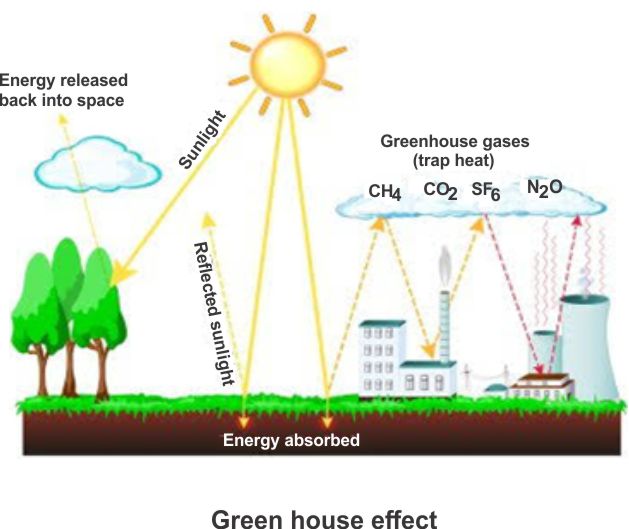
- The greenhouse effect, akin to a greenhouse, describes the process where Earth's surface and atmosphere are heated by solar radiation trapped by atmospheric gases, primarily carbon dioxide and methane.
- Without the greenhouse effect, Earth's average temperature would be significantly colder (-18°C), but the current average temperature is a comfortable 15°C, thanks to this phenomenon.
- Solar radiation is absorbed by Earth's surface, which then emits heat in the form of infrared radiation. Greenhouse gases in the atmosphere trap some of this heat, preventing it from escaping into space, thereby warming the planet.
- Carbon dioxide and methane are key greenhouse gases responsible for trapping heat in the atmosphere.
- Increased levels of greenhouse gases have intensified the greenhouse effect, leading to global warming. Over the past century, Earth's temperature has risen by 0.6°C, with significant impacts such as melting polar ice caps and rising sea levels.
- Global warming contributes to environmental changes and extreme weather events like the El Niño effect. Melting ice caps and glaciers threaten coastal areas with sea-level rise.
- To combat global warming, actions include reducing fossil fuel usage, improving energy efficiency, curbing deforestation, promoting afforestation, and managing population growth. International cooperation is crucial in reducing greenhouse gas emissions.
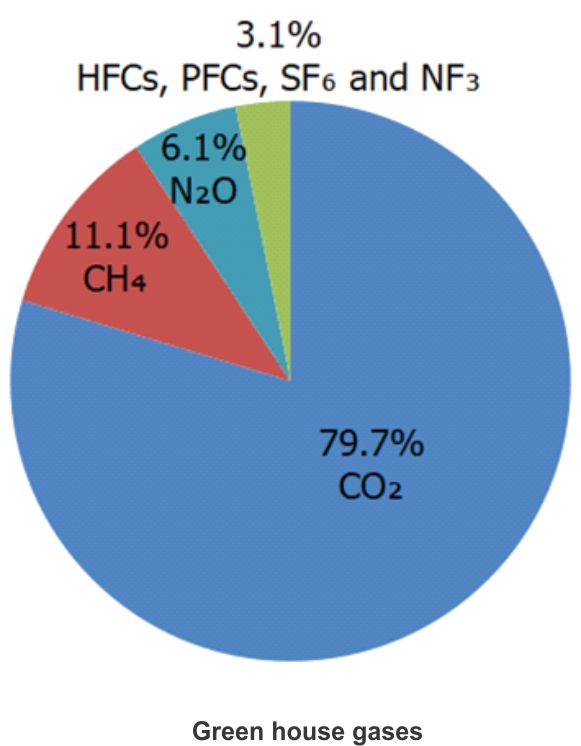
Ozone Depletion in the Stratosphere
- Ozone exists in two forms: "bad" ozone in the troposphere, harmful to living organisms, and "good" ozone in the stratosphere, which shields Earth from harmful ultraviolet (UV) radiation.
- Good ozone in the stratosphere absorbs UV radiation, preventing it from reaching Earth's surface. UV rays are damaging to living organisms, as they can break chemical bonds in DNA and proteins.
- The thickness of ozone in the stratosphere is measured in Dobson units (DU), indicating the concentration from the ground to the top of the atmosphere.
- Ozone is continuously formed and degraded in the stratosphere through natural processes. However, the balance has been disrupted by the release of chlorofluorocarbons (CFCs), commonly used as refrigerants.
- CFCs released into the atmosphere rise to the stratosphere, where UV radiation breaks them down, releasing chlorine (Cl) atoms. These Cl atoms catalytically degrade ozone, leading to ozone depletion.
- Particularly severe ozone depletion occurs over the Antarctic region, leading to the formation of the ozone hole, a large area of thinned ozone layer.
- UV-B radiation, which is not absorbed by the intact ozone layer, damages DNA, causes skin aging, skin cell damage, and increases the risk of skin cancers. UV-B exposure can also harm the eyes, causing conditions like snow-blindness and cataracts.
- The Montreal Protocol, signed in 1987, aimed to control the emission of ozone-depleting substances. It laid out roadmaps for reducing CFC emissions, with separate plans for developed and developing countries.
- Continued efforts have been made to reduce the emission of ozone-depleting chemicals, with protocols outlining specific actions and targets for countries worldwide. These efforts are crucial to preserving the ozone layer and mitigating the harmful effects of UV radiation.
Deforestation
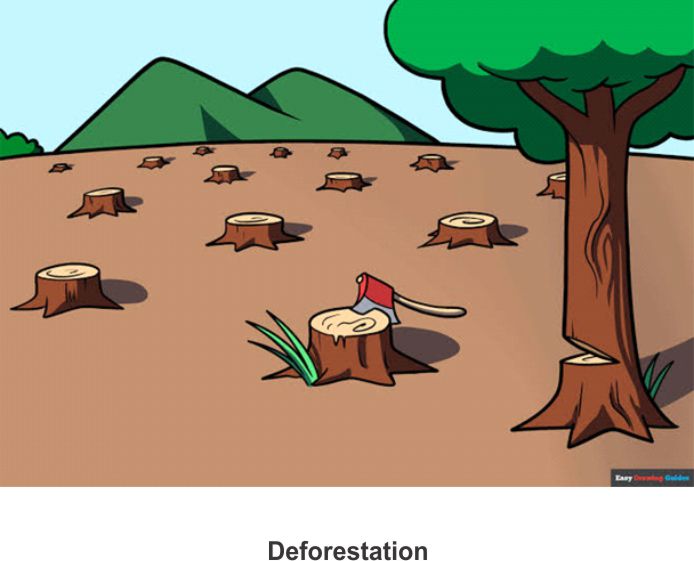
- Deforestation refers to the conversion of forested areas into non-forested ones, leading to the loss of forest cover.
- Approximately 40% of forests have been lost in tropical regions, compared to only 1% in temperate regions. In India, forest cover has decreased from 30% at the beginning of the twentieth century to 21.54% by the end of the century, falling short of the National Forest Policy's recommendation of 33% forest cover for plains and 67% for hills.
- Deforestation occurs due to various human activities, including conversion of forests into agricultural land to meet the demands of a growing population. Trees are also cut down for timber, firewood, and cattle ranching. Slash-and-burn agriculture, known as Jhum cultivation in northeastern India, involves cutting down trees, burning plant remains for fertilization, and using the land for farming or grazing. With increasing population pressure, recovery phases between cultivation cycles are reduced, accelerating deforestation.
- Deforestation results in increased carbon dioxide concentration in the atmosphere due to the loss of carbon-sequestering trees. It also leads to loss of biodiversity, habitat destruction, disruption of the hydrologic cycle, soil erosion, and potential desertification in extreme cases.
- Reforestation involves restoring a previously existing forest that was removed at some point. While natural reforestation can occur, human efforts to plant trees can accelerate the process. Reforestation initiatives should consider restoring biodiversity to the area.
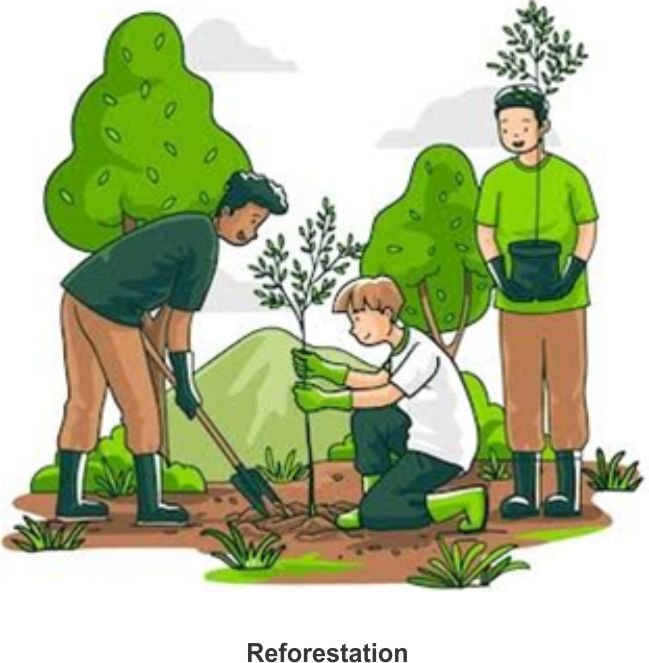
Degradation by Improper Resource Utilization and Maintenance
- Soil Erosion and Desertification: Human activities such as over-cultivation, unrestricted grazing, deforestation, and poor irrigation practices can lead to soil erosion, where fertile topsoil is easily removed. This degradation process can result in the formation of arid patches of land, eventually leading to desertification when barren patches merge over time. Desertification is a significant global issue exacerbated by increased urbanization.
- Waterlogging and Soil Salinity: Improper irrigation practices without adequate drainage can cause waterlogging in the soil. Waterlogging not only affects crop growth but also brings salts to the soil surface. These salts accumulate, forming a crust on the land or collecting around plant roots. Increased soil salinity inhibits crop growth and poses serious challenges to agriculture. Waterlogging and soil salinity have emerged as problems associated with the Green Revolution, impacting agricultural productivity negatively.
Case study : People's Participation in Conservation of Forests
- In 1731, in Rajasthan, the Bishnoi community demonstrated extraordinary commitment to protecting trees. When the king's men attempted to cut down trees for palace construction, Amrita Devi, a Bishnoi woman, courageously hugged a tree, declaring she would rather sacrifice her life than see the tree harmed. Despite her plea, the tree was cut down along with Amrita Devi and many others from the community. This act of sacrifice highlights the deep connection between the Bishnois and their environment.
- The Chipko Movement, which originated in the Garhwal Himalayas in 1974, saw local women bravely hugging trees to prevent them from being felled by contractors. This movement gained international recognition for its efforts in forest conservation.
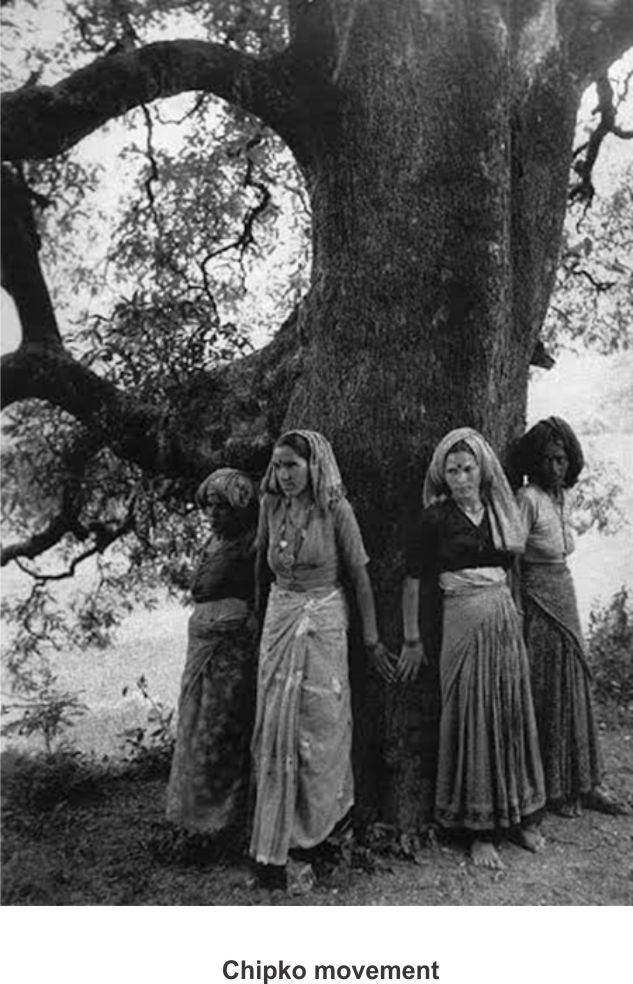
- Recognizing the importance of community involvement, the Government of India introduced the concept of Joint Forest Management (JFM) in the 1980s. Under JFM, local communities collaborate with forest authorities to protect and manage forests. In exchange for their services, communities benefit from various forest products such as fruits, gum, rubber, and medicine. This approach ensures sustainable forest conservation while providing livelihood opportunities to local residents.
- Amrita Devi Bishnoi Wildlife Protection Award: In honor of Amrita Devi and the Bishnoi community's dedication to wildlife protection, the Government of India has established the Amrita Devi Bishnoi Wildlife Protection Award. This award recognizes individuals or communities from rural areas who demonstrate extraordinary courage and commitment to wildlife conservation.